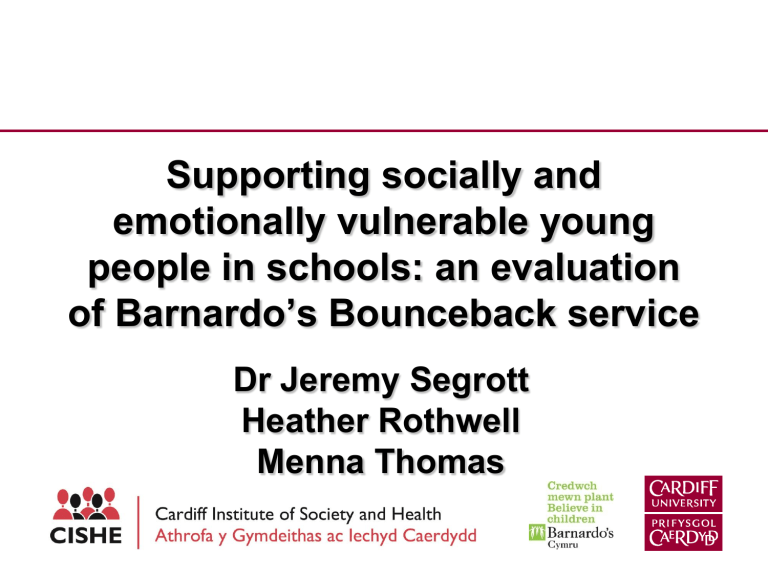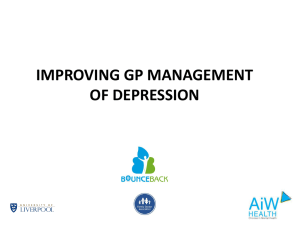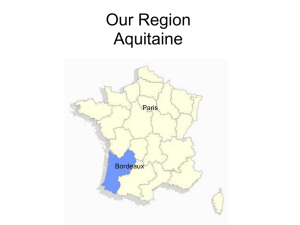Barnardos Bounceback - All Wales Mental Health Promotion

Supporting socially and emotionally vulnerable young people in schools: an evaluation of Barnardo’s Bounceback service
Dr Jeremy Segrott
Heather Rothwell
Menna Thomas
Presentation outline
Background
Evaluation aims and methods
Working with schools and young people
The wider organisational context
Acceptability
How Bounceback works
Present and future impact
Discussion
Discussion questions
1. In what ways does a service like Bounceback affect schools?
2. How should services like Bounceback operate in schools?
3. What is needed for school-based services like
Bounceback to run smoothly?
4. What is the potential impact of Bounceback on young people?
Background
• Some young people encounter difficulties just when they are trying to adjust to a more adult role
• Health and emotional issues
• Education and training
• Practical issues (e.g. housing)
• Rates of mental health problems increase during adolescence (Kessler, et al, 2005; Kidger, et al, 2009)
• Provision and take up of support services is an important issue
Background
• Extending Entitlement - supporting young people in
Wales; Cymry Ifanc
Role uncertainty
Delayed economic dependence
Impact of recession, and reduced employment opportunities for those without skills
Need for provision of tailored support and advice on education, employment, housing, health
• Strategies to support young people in relation to further/higher education and work (e.g. Learning
Pathways)
Barnardo’s
Marlborough Rd
Services
Provides services primarily, but not exclusively, to young people age 16 and over including:
• Support service for young parents
• Housing support service
• Seren – supporting BME and asylum seeking young women
• Secondary schools counselling service in the Vale of
Glamorgan
• Caterpillar – support service for children and young people with mental health problems
– Bounceback service
Barnardo’s
Bounceback
Service
• School-based
• Provides support for vulnerable 15 and 16 year olds as they negotiate the transition from school to independence
• - Targets those who are at high risk of struggling to achieve key aspects of transition such as accessing training or employment due to emotional difficulties, social isolation and lack of family support.
• Support begins when the young people are at school, but can continue after they leave
• The support is participative, offered on an individual basis and led by individual need
• Focuses on needs and wishes of individuals
• One-to-one support in a safe place
• Informal support, not counselling, led by young people’s needs
Barnardo’s
Bounceback
Service
Aims to:
• be solution focussed
• build resilience
• inform, facilitate and enable access to other services and sources of support
• provide appropriate and acceptable support for individual young people
• Located in three schools at time of our evaluation
Background
Schools have a key role in promoting health
( Dickinson, et al. 2003;
Kidger,et al, 2009; Spence and Short, 2007; World
Health Organization 1986)
One way they can promote emotional health is by providing targeted support for pupils who have identified needs
(Kidger et al. 2009)
Important that schools engage with pupils
(Kay et al. 2006;
Kidger et al. 2009)
Key characteristics of effective support services:
(a) High-quality relationships (Surf and Lynch 1999)
(b) Adequate time (Fox and Butler 2007)
(c) Confidentiality (Kay et al. 2006; Kidger et al. 2009; Fox and Butler 2007)
Background
External agencies can make an important contribution to school efforts to support pupils’ emotional health
(Wyn et al. 2000)
. . .
But face challenges related to their location in schools
(Ringeisen et al. 2003; Patton, et al. 2000;
Paternite 2005; Weist et al. 2001; Baruch 2001;
Kay et al. 2006)
The evaluation
• Partnership between Barnardo’s and Cardiff
University
• Focused on acceptability and theory-building
• Aims
• Explore the views of young people who use
Bounceback
• Examine the potential of Bounceback to prevent later emotional and mental health problems
• Examine how Bounceback fitted into schools, through investigating the views of Bounceback staff, school staff and pupils in Years 10 and 11
Recruitment and selection
• All Bounceback staff
• In each school, the senior teacher with responsibility for establishing and maintaining cooperation with Bounceback
• Users and ex users of Bounceback contacted through Bounceback staff
• In each school, Year 11 volunteers for focus groups
Methods
• Five interviews with Bounceback staff
• Interviews with four members of school staff
• Interviews with seven young people who had used Bounceback
• In each school, one focus group with pupils from the school population who were not using
Bounceback (total = 23), to explore their views on their school’s role in providing support for pupils
Findings: overview
• Working with schools
• Working with young people
• Acceptability
• How Bounceback works
• Initial impacts on young people
• Impact on schools
Working with schools
Bounceback staff developed a set of minimum requirements regarding:
Suitable accommodation
Effective mechanisms for contacting pupils
Timely completion and sharing of referral documentation
Clear referral criteria
Understanding that there was no compulsion for pupils to attend Bounceback
Working with young people
Flexible timing of appointments
Drop-in option if appointments were missed
Contact numbers for young people
No set number of sessions
Support continued after Year 11/during school holidays if needed
Wider organisational context
- Part of Caterpillar project
One of a range of services provided by Barnardo’s
- Key influence on quality of Bounceback service:
- Common ethos
- Easy referral routes
- Reliable information and guidance
Was everybody happy?
Acceptability
Yes – young people and school staff
More sessions for more pupils of all ages
- Half-hour drop-in sessions were suggested as a low-cost compromise, if more funding and staff were not affordable
- Bounceback users who had experience of other services said Bounceback was better
Acceptability
“ . . .when I was in care . . . they were the only ones who made the effort throughout the summer to keep in contact with me.” (Ex-
Bounceback user)
“the most important thing is . . . we want to continue using it . . . it’s invaluable, it’s four or five children you’re keeping out of all types of trouble.” (senior teacher, School3)
How Bounceback works
Choice
“they’re not strict about you, they’re not a service that forces you to talk. . .” (Bounceback user)
Equality
“... it was nice to know that they are not always going to have the answers. . . You kind of felt that even though they were older than you, you were kind of in the same boat, you were on the same level.”
(Ex-Bounceback user)
How Bounceback works
A safe place
“It’s like you go in and they know how to make you feel warm and welcome.” (Ex-Bounceback user)
Trust
“I sort of know it will be private cos I know
[Bounceback staff member]’s the kind of guy who won’t just go blabbing out ‘Oh yeah I went to the school yeah and this guy’s Nan died’ I know he’s not that sort of person, I know my information is safe with him. I just feel really trusted with him.”
(Bounceback user)
How Bounceback works
Listening
“[pupil] feels that actually somebody is coming in to school that wants to listen to her ” (Teacher School 2))
Talking through
“they never ever look down on you, or…criticise you unless…it’s constructive criticism if anything” (Ex-Bounceback user)
Initial impacts on young people
“Toolbox” of skills and strategies
- List of contact numbers
- Open door to return to Bounceback
- Increased self esteem and confidence
- Feeling more competent to deal with difficult situations
- Better able to concentrate on school work
- Increased ability to cope with the school environment – stayed longer in school
Initial impacts on young people
“They’ve [Bounceback users] gone from, not necessarily shrinking violets but people unable to perhaps communicate very well with adults and peers to people that can.”
(senior teacher, School 2)
“Emotionally I’d have got more upset, more unconfident in myself . . . I think I needed it in order to give me a boost for the rest of the year, the rest of the school.”
(Bounceback user)
C
H
O
I
C
E
Safe place
Trust
Listening
Talking through
Development of strategies - a
“toolbox”
Coping mechanisms, resilience
Relationshipbuilding activities e.g. Family tree
Child protection
Referral
Other support
Resiliencebuilding activities e.g. Confidence,
Boyfriends,
Aspirations
Impact on schools
Improvement in young people’s behaviour at school (senior teacher, School 1)
“[Bounceback]’s relieving us of doing what . .
.we [teachers] would end up trying to do but not doing it as successfully.” (senior teacher,
School 3)
Potential for long-term impact
- Important to estimate whether impact is only temporary, or is likely to last
- Identify links to theory
- Bounceback fits well with resiliency theory
- focus on individual, not on a particular problem
- suggests effects will be persistent
- Justifies further development and evaluation
Bounceback – the future
Bounceback-school relationship is a major influence on effectiveness of the service.
- Better communication could be made a condition of service provision e.g. commitment to a schedule of meetings
Continuity of care provided by
Bounceback distinguishes it from many other services offering support for young people
- Demands on Bounceback staff suggest desirability of clinical supervision, particularly in crisis situations
Bounceback – the future
Young people and school staff indicated a large amount of unmet need in each school
- Daily half-hour drop-in service could be considered as a low-cost option for providing support to more young people
Could Bounceback support young people who drop out of school in Years 10 and 11?
Development of a theoretical model for Bounceback is needed to guide further research
Discussion questions
• In what ways does a service like
Bounceback affect schools?
• How should services like Bounceback operate in schools?
• What is needed for school-based services like Bounceback to run smoothly?
• What is the potential impact of
Bounceback on young people?
Acknowledgements
Young people who were attending, or had attended
Bounceback
Shelly Godfrey, Nick Morgan, Catherine Rawlings, Joyce
Samuel and Sarah Smith of Barnardo’s
Pupils and staff at all study schools
Welsh Assembly Government Wales Office for Research and Development in Health and Social Care (WORD)
Colleagues at CISHE
References . . .
Baruch, G. 2001. Mental health services in schools: the challenge of locating a psychotherapy service for troubled adolescent pupils in mainstream and special schools. Journal of Adolescence 24(4), pp. 549-570.
Dickinson, P. et al. 2003. TRAVELLERS: a school-based early intervention programme helping young people manage and process change, loss and transition. Pilot phase findings. Australian & New Zealand Journal of Psychiatry 37(3), pp. 299-306.
Fox, C. L. and Butler, I. 2007. ‘If you don't want to tell anyone else you can tell her’: young people's views on school counselling. British Journal of Guidance &
Counselling 35(1), pp. 97 - 114.
Kay, C. M. et al. 2006. To what extent are school drop-in clinics meeting pupils' selfidentified health concerns? . Health Education Journal 65, pp. 236-251.
Kessler, R. C, Berglund, P, Demler, O, Jin, R, Merikangas, K. R, Walters, E. E (2005).
‘Lifetime Prevalence and Age-of-Onset Distributions of DSM-IV Disorders in the
National Comorbidity Survey Replication. Archives of General Psychiatry , 62: 593-
602.
Kidger, J. et al. 2009. Supporting adolescent emotional health in schools: a mixed methods study of student and staff views in England. BMC Public Health 9, p. 403.
Le Surf, A. and Lynch, G. 1999. Exploring young people's perceptions relevant to counselling: A qualitative study. British Journal of Guidance & Counselling 27(2), pp.
231 - 243.
. . .
Paternite, C. 2005. School-Based Mental Health Programs and Services:
Overview and Introduction to the Special Issue. Journal of Abnormal Child
Psychology 33(6), pp. 657-663.
Patton, G. C. et al. 2000. The Gatehouse Project: a systematic approach to mental health promotion in secondary schools. Australian & New Zealand
Journal of Psychiatry 34(4), pp. 586-593.
Spence, S. H. and Shortt, A. L. 2007. Research Review: Can we justify the widespread dissemination of universal, school-based interventions for the prevention of depression among children and adolescents? Journal of Child
Psychology and Psychiatry 48(6), pp. 526-542.
Weist, M. D. et al. 2001. Collaboration Among the Education, Mental Health, and Public Health Systems to Promote Youth Mental Health. Psychiatr Serv
52(10), pp. 1348-1351.
World Health Organization. 1986. Ottawa Charter for Health Promotion .
International Conference on Health Promotion Ottawa.
Wyn, J. et al. 2000. MindMatters, a whole-school approach promoting mental health and wellbeing. Australian & New Zealand Journal of Psychiatry 34(4), pp. 594-601.



![afl_mat[1]](http://s2.studylib.net/store/data/005387843_1-8371eaaba182de7da429cb4369cd28fc-300x300.png)



